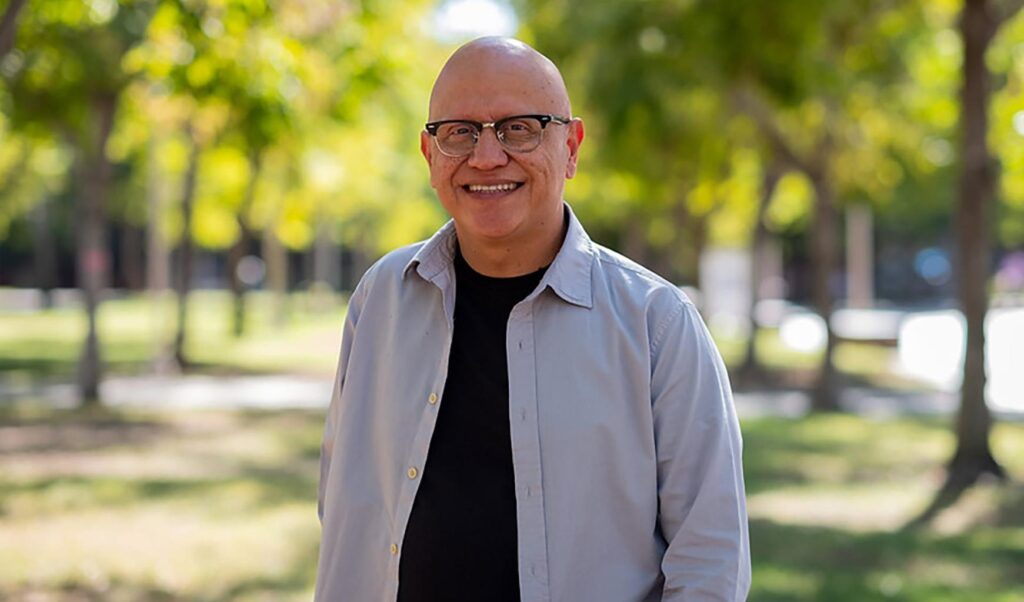“Writing and storytelling were a kind of escape from the violence and poverty I saw and experienced around me growing up. They were an opportunity for me to step out of my environment and create alternate worlds.”
—Alex Espinoza
“When someone pays attention to you, you feel like you have an identity, and you have meaning. I want them to have the same feeling. I want them to know that they are someone, that they are important.”
—Narsiso Martinez

Narsiso Martinez, Self-Portrait En La Cherry (with Strawberry Fields Forever in the Background), 2020. Ink, charcoal, gouache and acrylic matte gel on produce cardboard boxes.
Artist Narsiso Martinez and writer Alex Espinoza share their intersecting stories of family, place, identity, escape, and witness. In equally powerful narrative drawings and narrated words, these two artists create connections in situations and generations where disconnections often speak louder than truth or tenderness.
Book signing to follow.
Parallel Stories is a literary and performing arts series that pairs art and artists with award-winning authors and performers of regional, national, and international acclaim. This series functions as a multidisciplinary lens through which to view the Museum’s collection and special exhibitions.
Location: SBMA’s Mary Craig Auditorium, 1130 State Street, Santa Barbara
Free Students & Museum Circle/$10 SBMA Members/$15 Non-Members
Get tickets at tickets.sbma.net
More about Alex Espinoza:
 Alex Espinoza (he/him/his/they) is a queer writer with a disability. He was born in Tijuana, Mexico––on Kumeyaay original lands–– to Purepécha parents from the state of Michoacán and raised in Southern California, on Gabrieliño-Tongva land. His debut novel, Still Water Saints, was published to wide critical acclaim. His second novel, The Five Acts of Diego León, was the winner of a 2014 American Book Award from the Before Columbus Foundation. Other awards include fellowships from the Bread Loaf Writers’ Conference, the National Endowment for the Arts, and Macdowell.
Alex Espinoza (he/him/his/they) is a queer writer with a disability. He was born in Tijuana, Mexico––on Kumeyaay original lands–– to Purepécha parents from the state of Michoacán and raised in Southern California, on Gabrieliño-Tongva land. His debut novel, Still Water Saints, was published to wide critical acclaim. His second novel, The Five Acts of Diego León, was the winner of a 2014 American Book Award from the Before Columbus Foundation. Other awards include fellowships from the Bread Loaf Writers’ Conference, the National Endowment for the Arts, and Macdowell.
 He is the author of the nonfiction book Cruising: An Intimate History of a Radical Pastime and has written essays, reviews, and stories for the New York Times Sunday Magazine, Virginia Quarterly Review, the Los Angeles Times, LitHub, and NPR. His short story “Detainment” was selected for inclusion in the 2022 Best American Mystery and Suspense Stories. Alex lives in Los Angeles on Gabrieliño-Tongva land with his husband Kyle and teaches at the University of California, Riverside––within Tongva, Cahuilla, Luiseño & Serrano original lands––where he serves as the Tomás Rivera Endowed Chair and Professor of Creative Writing. His newest novel, The Sons of El Rey, was published in June 2024 from Simon and Schuster.
He is the author of the nonfiction book Cruising: An Intimate History of a Radical Pastime and has written essays, reviews, and stories for the New York Times Sunday Magazine, Virginia Quarterly Review, the Los Angeles Times, LitHub, and NPR. His short story “Detainment” was selected for inclusion in the 2022 Best American Mystery and Suspense Stories. Alex lives in Los Angeles on Gabrieliño-Tongva land with his husband Kyle and teaches at the University of California, Riverside––within Tongva, Cahuilla, Luiseño & Serrano original lands––where he serves as the Tomás Rivera Endowed Chair and Professor of Creative Writing. His newest novel, The Sons of El Rey, was published in June 2024 from Simon and Schuster.
More about Narsiso Martinez:
Narsiso Martinez (b. 1977, Oaxaca, Mexico) came to the United States when he was 20 years old. He attended Evans Community Adult School and completed high school in 2006 at the age of 29. He earned an Associate of Arts degree in 2009 from Los Angeles City College. In the fall of 2012 Narsiso earned his Bachelor of Fine Arts from California State University Long Beach. In the spring of 2018, he received a Master of Fine Arts degree in drawing and painting from California State University Long Beach and was awarded the prestigious Dedalus Foundation MFA Fellowship in Painting and Sculpture. His work has been exhibited both locally and internationally. His work is in the collections of the MFA Houston, LACMA, Buffalo AKG Museum, Hammer Museum, Amon Carter Museum of American Art, MOLAA, University of Arizona Museum of Art, Long Beach Museum of Art, Crocker Art Museum, Jordan Schnitzer Museum of Art at the University of Oregon, and the Santa Barbara Museum of Art. Martinez was awarded the Frieze Impact Award in 2023. Martinez lives and works in Los Angeles, CA and is represented by Charlie James Gallery.
Narsiso Martinez’s drawings and mixed media installations include multi-figure compositions set amidst agricultural landscapes. Drawn from his own experience as a farmworker, Martinez’s work focuses on the people performing the labors necessary to fill produce sections and restaurant kitchens around the country. Martinez’s portraits of farmworkers are painted, drawn, and expressed in sculpture on discarded produce boxes collected from grocery stores. In a style informed by 1930s-era Social Realism and heightened through use of found materials, Martinez makes visible the difficult labor and onerous conditions of the “American farmworker,” itself a compromised piece of language owing to the industry’s conspicuous use of undocumented workers.

